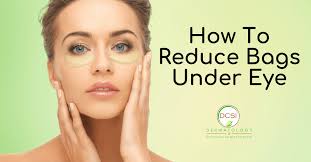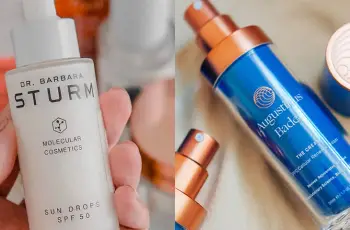
How to Get Rid of Bags Under Your Eyes: Causes, Remedies & Expert Tips
Bags under your eyes can make you look tired, older, and less vibrant, even when you’re feeling just fine.
They’re a frustrating beauty concern shared by men and women of all ages, often stubborn and hard to disguise.
While common, under-eye bags are among the top complaints people have when seeking cosmetic or skincare solutions.
To truly address this issue effectively, it’s important to first understand the various causes behind it.
Let’s dive into the science, lifestyle factors, and simple fixes to help reduce and prevent eye bags for good.
Why Do We Get Bags Under Our Eyes?
While many factors contribute to puffiness and shadows under the eyes, the truth is some of it is simply out of your hands.
Genetics plays a significant role—if you had eye bags as a child, it’s likely you inherited the condition from family.
Unfortunately, hereditary eye bags tend to be more difficult to eliminate completely, though some lifestyle changes may help.
However, there are several environmental and lifestyle triggers that can either cause or worsen the appearance of under-eye bags.
Let’s take a look at the most common causes—and how you can start to take control.
1. Sun Exposure
Too much sun exposure increases melanin production, which can darken the skin and make eye bags more pronounced.
The delicate skin under the eyes is particularly sensitive to UV rays and can become discolored or inflamed quickly.
This is one reason why people with more sun damage often report deeper shadows or puffiness in this area.
2. Fatigue and Lack of Sleep
It’s no surprise that lack of rest is one of the leading culprits when it comes to tired-looking eyes.
When you don’t get enough sleep, your skin can appear duller, allowing dark tissues and blood vessels to show more clearly.
This not only causes shadows under the eyes but may also result in swelling from fluid retention during poor sleep cycles.
3. Eye Strain From Screen Time
If you spend long hours staring at screens, you may be unknowingly contributing to under-eye puffiness and fatigue.
Digital eye strain can lead to inflammation and muscle tension, especially around the delicate orbital area.
This tightness can increase the visibility of bags or discoloration over time, especially if not addressed.
4. Dehydration
When your body is dehydrated, it struggles to maintain skin elasticity and circulation, making bags look worse.
Not drinking enough water can cause the skin under your eyes to appear sunken, dull, and more prone to puffiness.
Sometimes the solution is as simple as sipping more water consistently throughout your day.
5. Allergies
Allergic reactions can trigger inflammation and swelling under the eyes, sometimes referred to as “allergic shiners.”
Whether it’s pollen, dust, pets, or even certain skincare products, allergens can easily irritate this delicate zone.
Rubbing itchy eyes only makes matters worse by increasing irritation and promoting puffiness.
6. Fluid Retention
Sometimes, it’s just trapped fluid.
Sleeping flat or face-down can cause fluids to pool under the eyes, especially overnight.
This kind of swelling is usually worse in the morning and may subside gradually throughout the day.
7. Aging and Skin Changes
As we age, our skin naturally loses collagen and elasticity, and the fat pads under our eyes can shift or sag.
The muscles supporting the eyelids weaken over time, which makes puffiness and bags appear more noticeable.
While this is a natural part of the aging process, certain habits and treatments can help slow or mask the effects.
How to Treat and Prevent Bags Under Your Eyes
Now that we’ve explored the causes, let’s turn to effective ways you can reduce or even eliminate under-eye bags.
Some of these are simple at-home strategies, while others may require a more consistent skincare routine or lifestyle shift.
1. Sleep With Your Head Elevated
This small change can have a huge impact.
Using an extra pillow helps prevent fluid from collecting under your eyes while you sleep.
Lying flat or on your stomach can increase puffiness, while elevating your head allows better drainage.
Many people notice a dramatic difference just by making this adjustment—give it a try tonight!
2. Apply a Cold Compress
A cool compress can shrink dilated blood vessels and reduce swelling instantly.
Try chilled cucumber slices, a cold spoon, or a damp washcloth over your eyes for 10–15 minutes.
You can even keep your favorite gel eye mask in the fridge for a refreshing de-puffing session.
Cooling not only soothes irritation but also improves circulation and reduces inflammation.
3. Use a Targeted Eye Cream
Eye creams with caffeine, peptides, hyaluronic acid, or vitamin C can help firm, brighten, and hydrate the under-eye area.
Caffeine reduces swelling, while peptides strengthen the skin structure to minimize sagging over time.
Hyaluronic acid plumps the skin, and vitamin C helps fade discoloration and boosts collagen production.
Store your eye cream in the fridge for an extra cooling boost that can make a difference in minutes.
4. Check for Allergies
If you’re experiencing frequent puffiness or itchiness, an allergy test might reveal the true culprit.
Whether it’s a pet allergy, dust mites, or skincare sensitivities, addressing the root cause is crucial.
Once identified, managing your environment or using antihistamines can dramatically improve eye appearance.
5. Remove Makeup Before Bed
Sleeping with makeup can irritate the eyes and block pores, leading to puffiness and discoloration.
Make it a nightly ritual to gently remove all traces of makeup—especially around the eyes—before bed.
Use a micellar water or oil-based cleanser designed for sensitive skin to avoid further irritation.
6. Get Better Sleep (Not Just More)
It’s not just the number of hours, but the quality of sleep that matters when it comes to under-eye health.
Establish a regular bedtime routine, avoid screens for 1 hour before sleep, and try magnesium for deeper rest.
Consistent, restorative sleep can reduce cortisol levels and help diminish fluid retention under the eyes.
7. Avoid Smoking
Cigarettes accelerate aging by reducing blood flow and breaking down collagen, making bags worse.
Smoking also contributes to poor circulation and skin thinning, which increases puffiness and darkness under the eyes.
This is yet another reason to cut the habit—not just for your health but also your appearance.
8. Watch Your Salt Intake
Too much sodium in your diet can cause your body to retain water, leading to puffiness—especially around the eyes.
Start a food journal for a few days and monitor how much salt you consume in processed or restaurant foods.
Even reducing salty snacks or canned soups could help reduce swelling significantly.
9. Hydrate—And Set Water Reminders
Drinking more water helps flush toxins, improves skin tone, and reduces puffiness.
Carry a reusable water bottle with you, and try setting phone reminders to take sips throughout the day.
You’ll be surprised how quickly your skin responds to increased hydration.
10. Use SPF Every Day
Sun exposure is one of the main culprits behind premature skin aging, including around the eyes.
Applying SPF daily—yes, even in winter—helps protect this delicate area from UV damage.
Choose a gentle sunscreen made for facial use and apply it every morning as part of your routine.
11. Concealer for a Quick Fix
If you need an instant solution, a good concealer can help disguise the appearance of bags or discoloration.
Opt for a creamy, buildable formula close to your skin tone and blend it in gently with your ring finger or sponge.
Look for concealers with hydrating or brightening ingredients to avoid creasing or drying the area.
When to See a Professional
If you’ve tried lifestyle tweaks, creams, and remedies with little to no success, consider a dermatology consultation.
You may be a candidate for medical-grade treatments like laser resurfacing, fillers, or microneedling.
In some cases, surgical options like blepharoplasty may be recommended to permanently remove excess fat or skin.
Always consult with a licensed skincare professional to explore options tailored to your specific needs.
Final Thoughts
Under-eye bags may be common, but they don’t have to be your norm.
With the right combination of lifestyle adjustments, skincare products, and healthy habits, you can reduce puffiness and restore brightness to your eyes.
While some causes are genetic or age-related, most can be improved with just a few small changes to your daily routine.
Start with what’s in your control—better sleep, hydration, SPF, and smart skincare—and give your eyes the glow-up they deserve.


